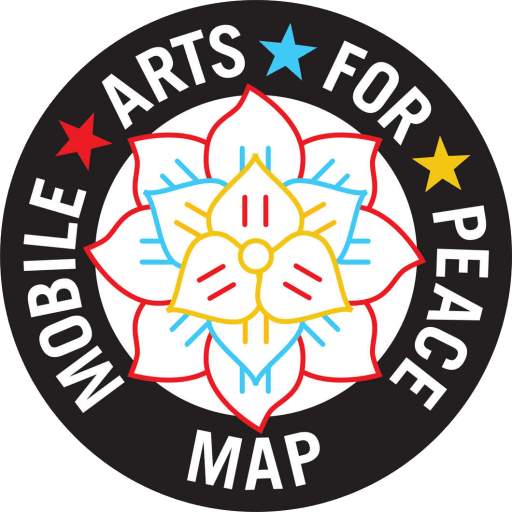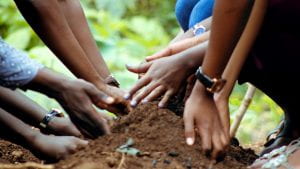By Anna Hata
Mobile Arts for Peace (MAP) and Learner-Centred Approach in Rwanda
‘MAP motivates and makes us free’ and helps to ‘resolve conflicts in our community,’ a youth member of Mobile Arts for Peace (MAP) announced proudly in his speech at the 3-day conference hosted by MAP and Changing the Story. Hosted in cooperation with the Institute of Research and Dialogue for Peace (IRDP) in Rwanda, this conference welcomed online participants from different countries worldwide from 5-7 August 2020.
MAP is a project led by Professor Ananda Breed from the University of Lincoln in collaboration with Dr. Eric Ndushabandi from IRDP in Rwanda. MAP works with young people, using the arts to share their experiences and voice their ideas for peacebuilding and dealing with conflicts in their communities. MAP has been introduced in all five of Rwanda’s provinces, serving over 25 schools, 300 teachers/trainers, and 2,500 young people. The Rwanda Education Board (REB) has also integrated the MAP method into the national curriculum framework in Music, Dance and Drama.
The learner-centered approach in education facilitated by the MAP matters for peacebuilding in Rwanda. In April 1994, the genocide against the Tutsi occurred in Rwanda, resulting in over 1,000,000 lives lost within about 100 days. This atrocity adversely affected Rwandan society, with schools destroyed, children and teachers killed, and many children and their families traumatised by witnessing unspeakable levels of violence. Historically speaking, education in Rwanda arguably emphasised the conceptualisation of enemies and allies as well as social stigmatisation along ethnic lines, through the structure of schooling and contents of schooling such as curriculum and pedagogy.
For example, schools were used to reinforce the ethnic divisions in the Belgian colonisation period (1919-1962). Schools were established and run under the indirect control of the Belgian colonial authority that favoured the incumbent Tutsi elite. Different ethnic identities experienced extremely limited access to basic education, and most primary and secondary school students were Tutsi, although they were estimated to have made up 10-15% of the population at that time. Moreover, history education consisted mostly of a Euro-centric Rwandan history, using a narrative such as, Tutsi were a superior race that came centuries ago from Ethiopia and dominated the Hutu. The situation changed dramatically in the Hutu-dominated government after Rwanda achieved independence in 1962. Education often played a harmful role in generating hatred between the Hutu and the Tutsi, and teachers in history classes used an opposite narrative to reinforce divisions. These classes included stating that the Tutsi colonised Rwanda. As such, education became a perpetrator, planting the seeds of genocide.
Currently, Rwanda is in a post-conflict phase focusing on a Rwandan identity to promote national unity and citizens free of prejudices and committed to human rights. In addition, all references to ethnic identities have been prohibited in public in favour of an emphasis on a shared Rwandan identity. In this context, learner-centered education approaches are critical for young people to engage in dialogue for peacebuilding.
How can MAP help to practice learner-centred approach?
Different art forms, such as sharing stories, performance and dance, are important to create a space for students to freely express their ideas and communicate with others to deal with their communities’ issues. By using these methods, MAP helps students build self-confidence in talking about themselves, not only for themselves but also to help others express their own stories. As Dr. Eric from IRDP argues, the key is ‘not only sharing your stories, but also listening to stories of others and mixing them to progress together’. By doing so, MAP would encourage to co-build psychosocial support. Students can learn to share stories as a way to discuss the problems they face, such as discrimination and corruption. MAP can promote peace through the arts, such as performances that students put on. For example, students perform a play on issues with regards to discriminatory practices against students with disabilities at school, family and community levels. It creates a space for students and the audience (teachers, communities, policymakers) to discuss the issue and how to make a better environment.
Professor Breed also emphasises the various benefits of MAP. Students can gain a lot of knowledge from each other and acquire crucial skills such as active listening, empathy, critical thinking, and public speaking skills, including those who did not previously have confidence. In this way, students can discover their talents. During the conference, youth members involved with MAP explained four important aspects of MAP from a student’s perspective: 1) to encourage students to be confident in themselves, 2) to strengthen ‘friendship’ between students and teachers, because when teachers start to listen, it strengthens the student-teacher relationship, 3) to make students perform better academically, as students can ask questions to teachers easily and comfortably, 4) to give students more opportunities to participate in dialogues which concern them. MAP encourages students to discover by themselves, instead of receiving everything from teachers. This active participation can give students a sense of ownership to navigate the peacebuilding process within their communities.
Similarly, MAP can bring benefits for teachers. MAP Master Trainers who have been training other teachers explained the effects brought on by MAP: 1) to bring peace on the ground by enabling students to use art, dance and other art forms to solve conflicts in their communities, 2) to make teachers confident in practicing peacebuilding, by discovering different ways to engage with students and gaining the skills to use arts, games and other methods in teaching 3) to facilitate community dialogue to bring community members together and discuss sensitive topics, particularly related to the past and build intergenerational conversations. Teachers become peacebuilders in their communities by critically thinking about different issues to solve them, and building trust in their everyday lives, both in school and society.
MAP highlights the importance of intergenerational dialogue which brings together teachers and students to create the foundations to affect a more just society. Through the MAP, teachers and students can learn how dialogues can relieve participants, encouraging them to share stories and find solutions. The MAP approach is adaptable to different local contexts. MAP is also being introduced in other post-conflict nations including Kyrgyzstan, Indonesia and Nepal. By using local arts, MAP’s approach can be applied to different societies to work with young people and use art to promote sustainable peace.
For further reflections on the ‘Arts-based Research for Education and Peacebuilding’ conference (hosted from 5–7 August see Beyond voice: expressing youth agency through arts-based approaches in Mobile Arts for Peace (MAP).


Recent Comments